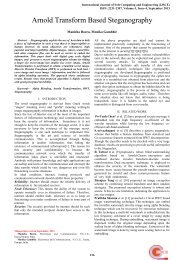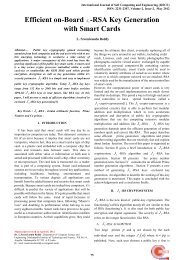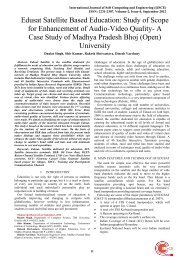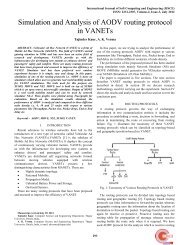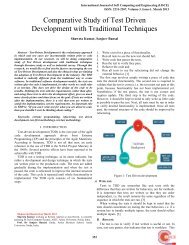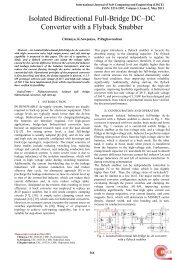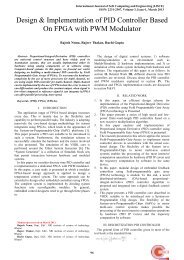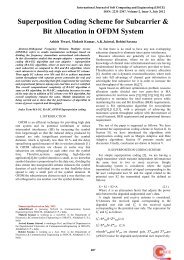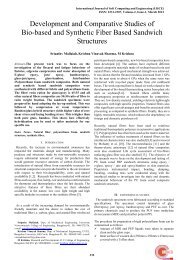Analysis of Stability in Carbon Nanotube and Graphene Nanoribbon ...
Analysis of Stability in Carbon Nanotube and Graphene Nanoribbon ...
Analysis of Stability in Carbon Nanotube and Graphene Nanoribbon ...
You also want an ePaper? Increase the reach of your titles
YUMPU automatically turns print PDFs into web optimized ePapers that Google loves.
International Journal <strong>of</strong> S<strong>of</strong>t Comput<strong>in</strong>g <strong>and</strong> Eng<strong>in</strong>eer<strong>in</strong>g (IJSCE)<br />
ISSN: 2231-2307, Volume-2, Issue-6, January 2013<br />
<strong>Analysis</strong> <strong>of</strong> <strong>Stability</strong> <strong>in</strong> <strong>Carbon</strong> <strong>Nanotube</strong> <strong>and</strong><br />
<strong>Graphene</strong> <strong>Nanoribbon</strong> Interconnects<br />
S<strong>and</strong>ip Bhattacharya, Subhajit Das, Debaprasad Das<br />
Abstract—This paper analyzes the stability <strong>of</strong> carbon nanotube<br />
(CNT) <strong>and</strong> graphene nanoribbon (GNR) based <strong>in</strong>terconnects for<br />
future VLSI technology node. We have analyzed both Bode <strong>and</strong><br />
Nyquist stability <strong>of</strong> s<strong>in</strong>gle-wall CNT, multi-wall CNT, GNR, <strong>and</strong><br />
copper based <strong>in</strong>terconnect systems. The stability analysis is<br />
performed for different <strong>in</strong>terconnect systems for 16nm ITRS<br />
technology node. It is shown that densely packed s<strong>in</strong>gle-wall CNT<br />
bundle based <strong>in</strong>terconnect has highest ga<strong>in</strong> marg<strong>in</strong> for a wide<br />
range <strong>of</strong> <strong>in</strong>terconnect length (1 m to 100 m) as compared to the<br />
other <strong>in</strong>terconnect systems.<br />
Index Terms—<strong>Carbon</strong> nanotube (CNT), graphene nanoribbon<br />
(GNR), stability.<br />
I. INTRODUCTION<br />
With the advancement <strong>of</strong> VLSI Technology the <strong>in</strong>terconnect<br />
dimensions are reduced from micron to submicron range <strong>and</strong><br />
submicron to nanometer range. In the nanometer regime the<br />
traditional copper based <strong>in</strong>terconnects will suffer serious<br />
problems due to <strong>in</strong>creased resistivity <strong>and</strong> susceptibility to<br />
electromigration. The carbon nanotube (CNT) <strong>and</strong> graphene<br />
nanoribbon (GNR) are proposed as the possible replacement<br />
for traditional copper (Cu) based <strong>in</strong>terconnect systems [1].<br />
CNT <strong>and</strong> GNR can support large current densities <strong>and</strong> have<br />
long mean free paths. In this paper we have analyzed Bode<br />
<strong>and</strong> Nyquist stabilities <strong>in</strong> different CNT <strong>and</strong> GNR<br />
<strong>in</strong>terconnect systems <strong>and</strong> compared the results with that <strong>of</strong> Cu<br />
based <strong>in</strong>terconnects.<br />
The paper is organized as follows. Section II describes the<br />
formulation <strong>of</strong> transfer function <strong>of</strong> <strong>in</strong>terconnects systems <strong>in</strong><br />
s-doma<strong>in</strong>. <strong>Analysis</strong> <strong>of</strong> Bode stability <strong>and</strong> Nyquist <strong>Stability</strong> is<br />
presented <strong>in</strong> Sections III <strong>and</strong> IV. The results are presented <strong>in</strong><br />
Section V, followed by the conclusions <strong>in</strong> Section VI.<br />
II. TRANSFER FUNCTION FORMULATION<br />
To <strong>in</strong>vestigate the stability <strong>of</strong> CNT <strong>and</strong> GNR based<br />
<strong>in</strong>terconnect system, we have formulated the transfer function<br />
<strong>of</strong> the <strong>in</strong>terconnect system. We have modeled the <strong>in</strong>terconnect<br />
system by a bundle <strong>of</strong> s<strong>in</strong>gle-wall CNT, multi-wall CNT, <strong>and</strong><br />
GNR. The dimensions <strong>of</strong> the <strong>in</strong>terconnect are obta<strong>in</strong>ed from<br />
the ITRS correspond<strong>in</strong>g to 16 nm technology node. Fig. 1<br />
illustrates the RLC network <strong>in</strong>terconnect systems. The RLC<br />
Manuscript received on January, 2013.<br />
S<strong>and</strong>ip Bhattacharya, Dept. <strong>of</strong> Electronics <strong>and</strong> Communication<br />
Eng<strong>in</strong>eer<strong>in</strong>g, Bengal College <strong>of</strong> Eng<strong>in</strong>eer<strong>in</strong>g <strong>and</strong> Technology, Durgapur,<br />
India.<br />
Subhajit Das, Dept <strong>of</strong> Electronics <strong>and</strong> Communication Eng<strong>in</strong>eer<strong>in</strong>g,<br />
ADAMAS Institute <strong>of</strong> Technology, Barasat, India.<br />
Debaprasad Das, Dept. <strong>of</strong> Electronics <strong>and</strong> Communication Eng<strong>in</strong>eer<strong>in</strong>g,<br />
Meghnad Saha Institute <strong>of</strong> Technology, Kolkata, India.<br />
equivalent circuit model is constituted with series connected<br />
resistance (R), <strong>in</strong>ductance (L), <strong>and</strong> capacitance (C).<br />
Fig. 1: Equivalent circuit <strong>of</strong> CNT/GNR <strong>in</strong>terconnects.<br />
The transfer function <strong>of</strong> the RLC circuit is given by<br />
V ( s)<br />
1<br />
H ( s)<br />
out<br />
(1)<br />
V ( s)<br />
( LCs<br />
2<br />
<strong>in</strong><br />
RCs 1)<br />
where R is the series comb<strong>in</strong>ation <strong>of</strong> imperfect contact<br />
resistance (R C ), quantum resistance (R Q ), <strong>and</strong> ohmic<br />
resistance (R O ), L is the series comb<strong>in</strong>ation <strong>of</strong> k<strong>in</strong>etic<br />
<strong>in</strong>ductance (L K /4) <strong>and</strong> magnetic <strong>in</strong>ductance (L M ), <strong>and</strong> C is the<br />
series comb<strong>in</strong>ation <strong>of</strong> electrostatic capacitance (C E ) <strong>and</strong><br />
quantum capacitance (4C Q ). The RLC parameters are<br />
obta<strong>in</strong>ed from [2 4] for SWCNT bundle, MWCNT <strong>and</strong> GNR<br />
based <strong>in</strong>terconnects for 16 nm technology node. Substitut<strong>in</strong>g<br />
the RLC values <strong>in</strong>to (1) we have obta<strong>in</strong>ed the transfer function<br />
<strong>of</strong> the <strong>in</strong>terconnect system.<br />
III. BODE STABILITY ANALYSIS<br />
We have used the stability analysis model as shown <strong>in</strong> Fig.<br />
2 [5]. A s<strong>in</strong>gle horizontal <strong>in</strong>terconnect segment connected<br />
with load <strong>and</strong> driver is considered. We have applied a step<br />
<strong>in</strong>put to the system to check the step response <strong>of</strong> the system.<br />
To <strong>in</strong>vestigate the stability <strong>of</strong> the system we have considered<br />
three different conditions for stability: (i) whether the system<br />
is over damped, (ii) under damped, or (iii) critically damped.<br />
Generally damp<strong>in</strong>g condition is determ<strong>in</strong>ed by damp<strong>in</strong>g ratio<br />
(ζ). If ζ > 1, the system is over damped, if ζ = 1, the system is<br />
critically damped, <strong>and</strong> if 0 < ζ < 1, the system is under<br />
damped.<br />
Consider an under damped system <strong>and</strong> an over damped<br />
system with the same un-damped natural frequency, but<br />
damp<strong>in</strong>g ratios ζ u <strong>and</strong> ζ o , respectively. It is shown that the<br />
under damped system is more stable <strong>and</strong> faster than the over<br />
damped system if <strong>and</strong> only if [5]<br />
325
<strong>Analysis</strong> <strong>of</strong> <strong>Stability</strong> <strong>in</strong> <strong>Carbon</strong> <strong>Nanotube</strong> <strong>and</strong> <strong>Graphene</strong> <strong>Nanoribbon</strong> Interconnects<br />
Fig. 2: Step response <strong>of</strong> an RLC network.<br />
o<br />
2<br />
1<br />
u<br />
2 u<br />
In this work we have studied stability <strong>of</strong> the <strong>in</strong>terconnect<br />
system by <strong>in</strong>creas<strong>in</strong>g the length <strong>of</strong> both <strong>in</strong>terconnect from 1<br />
m to 100 m. As the length <strong>of</strong> the <strong>in</strong>terconnect is <strong>in</strong>creased<br />
the switch<strong>in</strong>g delay <strong>of</strong> the RLC network is also <strong>in</strong>creased.<br />
Thus the system becomes over damped <strong>and</strong> it is said to be<br />
sluggish system <strong>and</strong> it reaches to the unstable condition [5].<br />
We have analyzed the Bode stability us<strong>in</strong>g MATLAB<br />
version 10. In Bode plot, the magnitude (<strong>in</strong> dB) <strong>and</strong> phase (<strong>in</strong><br />
deg.) are plotted along the Y-axis with respect to frequency<br />
along the X-axis. Us<strong>in</strong>g MATLAB programm<strong>in</strong>g we have<br />
calculated the ga<strong>in</strong> marg<strong>in</strong> (GM) <strong>and</strong> phase marg<strong>in</strong> (PM) <strong>of</strong><br />
the <strong>in</strong>terconnect system. Phase marg<strong>in</strong> is basically the<br />
difference between 180 o <strong>and</strong> the phase at 0 dB cross po<strong>in</strong>t <strong>of</strong><br />
the ga<strong>in</strong> curve. Ga<strong>in</strong> marg<strong>in</strong> is just the amount <strong>of</strong> ga<strong>in</strong> that can<br />
be added to move to the 0 dB l<strong>in</strong>e at the phase crossover<br />
frequency. The system becomes more stable if the GM <strong>and</strong><br />
PM <strong>in</strong>crease [6].<br />
IV. NYQUIST STABILITY ANALYSIS<br />
Nyquist stability analysis technique is implemented on the<br />
same model for further verification. Us<strong>in</strong>g this stability<br />
analysis we can further verify that our previous model gives<br />
us same response or not. A Nyquist plot is a parametric plot <strong>of</strong><br />
a transfer function used <strong>in</strong> automatic control <strong>and</strong> signal<br />
process<strong>in</strong>g. The most common use <strong>of</strong> Nyquist plots is for<br />
assess<strong>in</strong>g the stability <strong>of</strong> a system with feedback. In Cartesian<br />
coord<strong>in</strong>ates, the real part <strong>of</strong> the transfer function is plotted on<br />
the X axis. The imag<strong>in</strong>ary part is plotted on the Y axis. The<br />
frequency is swept as a parameter, result<strong>in</strong>g <strong>in</strong> a plot per<br />
frequency. Alternatively, <strong>in</strong> polar coord<strong>in</strong>ates, the ga<strong>in</strong> <strong>of</strong> the<br />
(2)<br />
transfer function is plotted as the radial coord<strong>in</strong>ate, while the<br />
phase <strong>of</strong> the transfer function is plotted as the angular<br />
coord<strong>in</strong>ate [7].<br />
Assessment <strong>of</strong> the stability <strong>of</strong> a closed-loop negative<br />
feedback system is done by apply<strong>in</strong>g the Nyquist stability<br />
criterion to the Nyquist plot <strong>of</strong> the open-loop system (i.e., the<br />
same system without its feedback loop). This method is easily<br />
applicable even for systems with delays <strong>and</strong> other<br />
non-rational transfer functions, which may appear difficult to<br />
analyze by means <strong>of</strong> other methods. <strong>Stability</strong> is determ<strong>in</strong>ed by<br />
look<strong>in</strong>g at the number <strong>of</strong> encirclements <strong>of</strong> the po<strong>in</strong>t at ( 1,0).<br />
Range <strong>of</strong> ga<strong>in</strong>s over which the system will be stable can be<br />
determ<strong>in</strong>ed by look<strong>in</strong>g at cross<strong>in</strong>g <strong>of</strong> the real axis.<br />
The Nyquist plot can provide some <strong>in</strong>formation about the<br />
shape <strong>of</strong> the transfer function. For <strong>in</strong>stance, the plot provides<br />
<strong>in</strong>formation on the difference between the number <strong>of</strong> poles<br />
<strong>and</strong> zeros <strong>of</strong> the transfer function [8] by the angle at which the<br />
curve approaches the orig<strong>in</strong>.<br />
V. STABILITY ANALYSIS RESULTS<br />
In this work we have varied the length <strong>of</strong> the CNT <strong>and</strong> GNR<br />
<strong>in</strong>terconnects from 1 µm to 100 µm for 16 nm technology<br />
node <strong>and</strong> generated various Bode plots <strong>and</strong> Nyquist plots.<br />
From the Bode plot plots we have studied the relative stability<br />
<strong>of</strong> the system shown <strong>in</strong> Figures 3 to 9. Table I shows the ga<strong>in</strong><br />
marg<strong>in</strong> <strong>and</strong> phase marg<strong>in</strong> <strong>of</strong> different <strong>in</strong>terconnect systems.<br />
From Nyquist diagram Figures 11 to 17, we also studied the<br />
relative stability <strong>of</strong> the GNR, CNT <strong>and</strong> Copper <strong>in</strong>terconnects.<br />
Here Most <strong>of</strong> the <strong>in</strong>terconnects shows stability because there<br />
is no pole <strong>in</strong> right h<strong>and</strong> side <strong>of</strong> the S Plane <strong>and</strong> also the number<br />
<strong>of</strong> encirclements <strong>of</strong> the po<strong>in</strong>t present at ( 1, 0). Beyond the -1<br />
<strong>of</strong> the real axis the system will become unstable. But our<br />
analysis shows that all encircle pass through the orig<strong>in</strong> <strong>and</strong><br />
overlapped for SWCNT bundle with densely packed CNTs<br />
with different <strong>in</strong>terconnects length shown <strong>in</strong> Figure 11. So<br />
stability is higher than other <strong>in</strong>terconnects <strong>in</strong> SWCNT bundle<br />
with densely packed <strong>in</strong>terconnects. But <strong>in</strong> case <strong>of</strong> GNR<br />
<strong>in</strong>terconnects it shows poor stability when length is equal to<br />
1µm, 5 µm, <strong>and</strong> 10 µm. If we want to <strong>in</strong>crease the<br />
<strong>in</strong>terconnect length <strong>of</strong> GNR from 50 µm to 100 µm it shows<br />
some stability because the encirclements <strong>of</strong> the contour<br />
presents between -1 to 0 <strong>in</strong> the real axis.<br />
TABLE I<br />
GAIN MARGIN AND PHASE MARGIN OF DIFFERENT INTERCONNECT SYSTEMS<br />
GAIN MARGIN (GM) IN dB, PHASE MARGIN (PM) IN Degree.<br />
Interconnect Length (µm) → 1 5 10 50 100<br />
Types <strong>of</strong> Interconnect ↓ GM PM GM PM GM PM GM PM GM PM<br />
SWCNT bundle densely packed 293 90 283 90 280 90 277 90 277 90<br />
SWCNT bundle sparsely packed 270 90 258 90 253 90 245 90 243 90<br />
S<strong>in</strong>gle MWCNT 244 90 232 90 228 90 223 90 222 90<br />
MWCNT bundle <strong>of</strong> 2 MWCNTs 244 90 232 90 228 90 223 90 222 90<br />
MWCNT bundle <strong>of</strong> 8 MWCNTs 248 90 238 90 235 90 231 90 231 90<br />
<strong>Graphene</strong> <strong>Nanoribbon</strong> (GNR) 250 90 245 90 244 90 243 90 225 90<br />
Copper (Cu) 285 90 282 90 281 90 279 90 278 90<br />
326
International Journal <strong>of</strong> S<strong>of</strong>t Comput<strong>in</strong>g <strong>and</strong> Eng<strong>in</strong>eer<strong>in</strong>g (IJSCE)<br />
ISSN: 2231-2307, Volume-2, Issue-6, January 2013<br />
Fig. 3: Bode plot for SWCNT bundle with densely packed<br />
CNTs.<br />
Fig. 6: Bode plot for double MWCNT.<br />
Fig. 4: Bode plot for SWCNT bundle with sparsely packed<br />
CNTs.<br />
Fig. 7: Bode plot for MWCNT bundle with eight MWCNTs.<br />
Fig. 5: Bode plot for s<strong>in</strong>gle MWCNT.<br />
Fig. 8: Bode plot for GNR <strong>in</strong>terconnect.<br />
327
Imag<strong>in</strong>ary Axis<br />
Imag<strong>in</strong>ary Axis<br />
Imag<strong>in</strong>ary Axis<br />
Imag<strong>in</strong>ary Axis<br />
Imag<strong>in</strong>ary Axis<br />
<strong>Analysis</strong> <strong>of</strong> <strong>Stability</strong> <strong>in</strong> <strong>Carbon</strong> <strong>Nanotube</strong> <strong>and</strong> <strong>Graphene</strong> <strong>Nanoribbon</strong> Interconnects<br />
1.5<br />
1<br />
0.5<br />
Nyquist Diagram <strong>of</strong> S<strong>in</strong>gle MWCNT<br />
L_1um<br />
L_5um<br />
L_10um<br />
L_50um<br />
L_100um<br />
0<br />
-0.5<br />
Fig. 9: Bode plot for copper <strong>in</strong>terconnect.<br />
-1<br />
-1.5<br />
-2 -1.5 -1 -0.5 0 0.5 1 1.5 2<br />
Real Axis<br />
Fig. 13: Nyquist plot for s<strong>in</strong>gle MWCNT.<br />
1<br />
0.5<br />
Nyquist Diagram <strong>of</strong> MWCNT Bundle with two MWCNTs <strong>in</strong> vertical direction<br />
L_1um<br />
L_5um<br />
L_10um<br />
L_50um<br />
L_100um<br />
Fig. 10: Experimental data for GNR, CNT <strong>and</strong> Copper<br />
<strong>in</strong>terconnects.<br />
Nyquist Diagram <strong>of</strong> SWCNT Interconnect Densely Packed with Metallic fraction Pm=1, Rc=100K-Ohm<br />
1<br />
L_1um<br />
L_5um<br />
L_10um<br />
0.5<br />
L_50um<br />
L_100um<br />
0<br />
-0.5<br />
-1<br />
-1.5 -1 -0.5 0 0.5 1 1.5<br />
Real Axis<br />
Fig. 11: Nyquist plot for SWCNT bundle with densely packed<br />
CNTs.<br />
Nyquist Diagram <strong>of</strong> SWCNT Interconnect Sparsely Packed with Metallic fraction Pm=1/3, Rc=100K-Ohm<br />
1<br />
L_1um<br />
L_5um<br />
L_10um<br />
0.5<br />
L_50um<br />
L_100um<br />
0<br />
-0.5<br />
-1<br />
-1.5 -1 -0.5 0 0.5 1 1.5<br />
Real Axis<br />
Fig. 14: Nyquist plot for MWCNT Bundle with two<br />
MWCNTs <strong>in</strong> vertical direction.<br />
1<br />
0.5<br />
0<br />
Nyquist Diagram <strong>of</strong> MWCNT Bundle with eight MWCNTs <strong>in</strong> vertical direction<br />
L_1um<br />
L_5um<br />
L_10um<br />
L_50um<br />
L_100um<br />
0<br />
-0.5<br />
-0.5<br />
-1<br />
-1.5 -1 -0.5 0 0.5 1 1.5<br />
Real Axis<br />
Fig. 12: Nyquist plot for SWCNT bundle with sparsely<br />
packed CNTs.<br />
-1<br />
-1.5 -1 -0.5 0 0.5 1 1.5<br />
Real Axis<br />
Fig. 15: Nyquist plot for MWCNT Bundle with eight<br />
MWCNTs <strong>in</strong> vertical direction.<br />
328
Imag<strong>in</strong>ary Axis<br />
Imag<strong>in</strong>ary Axis<br />
International Journal <strong>of</strong> S<strong>of</strong>t Comput<strong>in</strong>g <strong>and</strong> Eng<strong>in</strong>eer<strong>in</strong>g (IJSCE)<br />
ISSN: 2231-2307, Volume-2, Issue-6, January 2013<br />
20<br />
15<br />
10<br />
5<br />
Nyquist Diagram <strong>of</strong> GNR Interconnects.<br />
L_1um<br />
L_5um<br />
L_10um<br />
L_50um<br />
L_100um<br />
[5] S<strong>and</strong>ip Bhattacharya, Subhajit Das, Debaprasad Das, “<strong>Analysis</strong> <strong>of</strong><br />
<strong>Stability</strong> <strong>in</strong> <strong>Carbon</strong> <strong>Nanotube</strong> Interconnects”, <strong>in</strong> Proc. National<br />
Conference on Recent Advances <strong>in</strong> Applied Mathematics (NCRAAM),<br />
18 th Feb. 2012, pp. 34-39.<br />
[6] R. C. Dorf, R. H. Bishop, Modern Control System, 11th Ed.,<br />
Englewood Cliffs, NJ: Prentice-Halls, 2008.<br />
[7] http://en.wikipedia.org/wiki/Nyquist_plot.<br />
[8] http://www.facstaff.bucknell.edu/mastascu/econtrolhtml/Freq/Freq6.h<br />
tml<br />
0<br />
-5<br />
-10<br />
-15<br />
-20<br />
-15 -10 -5 0 5 10 15<br />
Real Axis<br />
Fig. 16: Nyquist plot for GNR <strong>in</strong>terconnects<br />
2<br />
1.5<br />
1<br />
0.5<br />
0<br />
-0.5<br />
-1<br />
-1.5<br />
Nyquist Diagram <strong>of</strong> Copper Interconnects.<br />
L_1um<br />
L_5um<br />
L_10um<br />
L_50um<br />
L_100um<br />
-2<br />
-1.5 -1 -0.5 0 0.5 1 1.5<br />
Real Axis<br />
Fig. 17: Nyquist plot for copper <strong>in</strong>terconnect.<br />
S<strong>and</strong>ip Bhattacharya was born <strong>in</strong> P<strong>and</strong>aveswar,<br />
Burdwan, West Bengal, India, on July 21st, 1983.<br />
He received the B.E. degree <strong>in</strong> Electronics <strong>and</strong><br />
Communication Eng<strong>in</strong>eer<strong>in</strong>g from University<br />
Institute <strong>of</strong> Technology, University <strong>of</strong> Burdwan,<br />
India <strong>in</strong> 2006 <strong>and</strong> the M.Tech. degree <strong>in</strong><br />
Electronics <strong>and</strong> Communication Eng<strong>in</strong>eer<strong>in</strong>g<br />
(Embedded Systems) from Haldia Institute <strong>of</strong><br />
Technology, <strong>in</strong> 2011. From 2006 to 2009, he was a<br />
S<strong>of</strong>tware Eng<strong>in</strong>eer <strong>in</strong> Indus net Technology,<br />
Salt-Lake Kolkata, India. He jo<strong>in</strong>ed the Department <strong>of</strong> Electronics <strong>and</strong><br />
Communication Eng<strong>in</strong>eer<strong>in</strong>g, Bengal College <strong>of</strong> Eng<strong>in</strong>eer<strong>in</strong>g <strong>and</strong><br />
Technology, Durgapur, India <strong>in</strong> 2011, where he is currently an Assistant<br />
Pr<strong>of</strong>essor. His research <strong>in</strong>terests <strong>in</strong>clude VLSI design, digital CMOS logic<br />
design, <strong>and</strong> model<strong>in</strong>g <strong>of</strong> nanoelectronic devices <strong>and</strong> <strong>in</strong>terconnects, FPGA<br />
based application development.<br />
Subhajit Das was born <strong>in</strong> Diamond Harbour,<br />
South 24 pgs, West Bengal, India, on December<br />
3rd, 1981. He received the B.Tech degree <strong>in</strong><br />
Electronics <strong>and</strong> Communication Eng<strong>in</strong>eer<strong>in</strong>g from<br />
Kalyani Govt. Eng<strong>in</strong>eer<strong>in</strong>g College, Kalyani, India<br />
<strong>in</strong> 2006 <strong>and</strong> the M.Tech degree <strong>in</strong> Electronics <strong>and</strong><br />
Communication Eng<strong>in</strong>eer<strong>in</strong>g (Embedded Systems)<br />
from Haldia Institute <strong>of</strong> Technology, <strong>in</strong> 2011. From<br />
2006 to 2008, he was a Senior Project Eng<strong>in</strong>eer at<br />
the embedded systems research & development<br />
section, Wipro Tech., Bangalore, India. Presently<br />
he is work<strong>in</strong>g <strong>in</strong> the Department <strong>of</strong> Electronics <strong>and</strong> Communication<br />
Eng<strong>in</strong>eer<strong>in</strong>g, ADAMAS Institute <strong>of</strong> Technology, Barasat, as an Assistant<br />
Pr<strong>of</strong>essor. He also contributed as guest lecturer <strong>in</strong> University Institute <strong>of</strong><br />
Technology, Burdwan, India. His research <strong>in</strong>terests <strong>in</strong>clude VLSI design,<br />
digital CMOS logic design, <strong>and</strong> model<strong>in</strong>g <strong>of</strong> nanoelectronic devices <strong>and</strong><br />
<strong>in</strong>terconnect.<br />
VI. CONCLUSIONS<br />
In this paper we have <strong>in</strong>vestigated the relative stability <strong>of</strong><br />
carbon nanotube <strong>and</strong> graphene nanoribbon <strong>in</strong>terconnects for<br />
16 nm ITRS technology node. From the Bode plots, we have<br />
shown that as the length <strong>of</strong> <strong>in</strong>terconnects <strong>in</strong>creases, the<br />
relative stability decreases. This is due to fact that, the<br />
<strong>in</strong>crease <strong>in</strong> <strong>in</strong>terconnect length <strong>of</strong> the system will cause<br />
<strong>in</strong>creased <strong>in</strong>terconnect delay. Thus, the step response <strong>of</strong> the<br />
system tends to become more sluggish <strong>in</strong> nature (over<br />
damped), <strong>and</strong> hence the system becomes more unstable.<br />
REFERENCES<br />
[1] International Technology Roadmap for Semiconductors (ITRS)<br />
reports, 2006. [Onl<strong>in</strong>e]. Available: http://www.itrs.net/reports.html<br />
[2] Debaprasad Das <strong>and</strong> Hafizur Rahaman, “Crosstalk overshoot/<br />
undershoot analysis <strong>and</strong> its impact on gate oxide reliability <strong>in</strong><br />
multi-wall carbon nanotube <strong>in</strong>terconnects”, Journal on Computational<br />
Electronics, Spr<strong>in</strong>ger, vol. 10, no. 4, pp. 360-372, Dec. 2011.<br />
[3] Debaprasad Das <strong>and</strong> Hafizur Rahaman, “<strong>Analysis</strong> <strong>of</strong> Crosstalk <strong>in</strong><br />
S<strong>in</strong>gle- <strong>and</strong> Multiwall <strong>Carbon</strong> <strong>Nanotube</strong> Interconnects <strong>and</strong> Its Impact<br />
on Gate Oxide Reliability”, IEEE Transactions on Nanotechnology,<br />
vol. 10, no. 6, Nov. 2011.<br />
[4] Debaprasad Das <strong>and</strong> Hafizur Rahaman, “Crosstalk <strong>and</strong> Gate Oxide<br />
Reliability <strong>Analysis</strong> <strong>in</strong> <strong>Graphene</strong> <strong>Nanoribbon</strong> Interconnects”, <strong>in</strong> Proc.<br />
2nd International Symposium on Electronic System Design (ISED),<br />
19-21 Dec. 2011, pp. 182-187.<br />
Debaprasad Das was born <strong>in</strong> Haria, Purba<br />
Med<strong>in</strong>ipur, India, on May 10, 1975. He received<br />
the B.Sc. (Hons.) <strong>in</strong> Physics <strong>in</strong> 1995, B.Tech. <strong>in</strong><br />
Radio Physics <strong>and</strong> Electronics <strong>in</strong> 1998, <strong>and</strong> M.E.<br />
<strong>in</strong> Electronics <strong>and</strong> Telecommunication<br />
Eng<strong>in</strong>eer<strong>in</strong>g <strong>in</strong> 2006 degrees from the Vidyasagar<br />
University, University <strong>of</strong> Calcutta, <strong>and</strong> Jadavpur<br />
University, respectively. He was with the ASIC<br />
Product Development Centre, Texas Instruments,<br />
Bangalore, as a senior eng<strong>in</strong>eer from 1998 to 2003.<br />
He jo<strong>in</strong>ed the Dept. <strong>of</strong> Electronics <strong>and</strong> Communication Eng<strong>in</strong>eer<strong>in</strong>g,<br />
Meghnad Saha Institute <strong>of</strong> Technology, Kolkata, <strong>in</strong> 2003, where he is<br />
currently an Assistant Pr<strong>of</strong>essor. He is also work<strong>in</strong>g for the Ph.D. degree at<br />
School <strong>of</strong> VLSI Technology, Bengal Eng<strong>in</strong>eer<strong>in</strong>g <strong>and</strong> Science University,<br />
Shibpur. He has authored or co-authored several research papers <strong>in</strong> National<br />
<strong>and</strong> International Journals <strong>and</strong> Conferences. He is author <strong>of</strong> the book VLSI<br />
Design (New Delhi: Oxford University Press, 2010). He has also authored<br />
two books published by Lambert Academic Publish<strong>in</strong>g, Germany. His<br />
research <strong>in</strong>terests <strong>in</strong>clude VLSI design, develop<strong>in</strong>g <strong>of</strong> EDA tools for<br />
<strong>in</strong>terconnect model<strong>in</strong>g, analyz<strong>in</strong>g crosstalk <strong>and</strong> reliability, digital CMOS<br />
logic design, <strong>and</strong> model<strong>in</strong>g <strong>of</strong> nanoelectronic devices <strong>and</strong> <strong>in</strong>terconnects. Mr.<br />
Das received gold medal from Vidyasagar University <strong>in</strong> 1997 for rank<strong>in</strong>g<br />
first <strong>in</strong> the undergraduate degree. He received First Place Award <strong>in</strong> PhD<br />
forum at VDAT 2012.<br />
329



